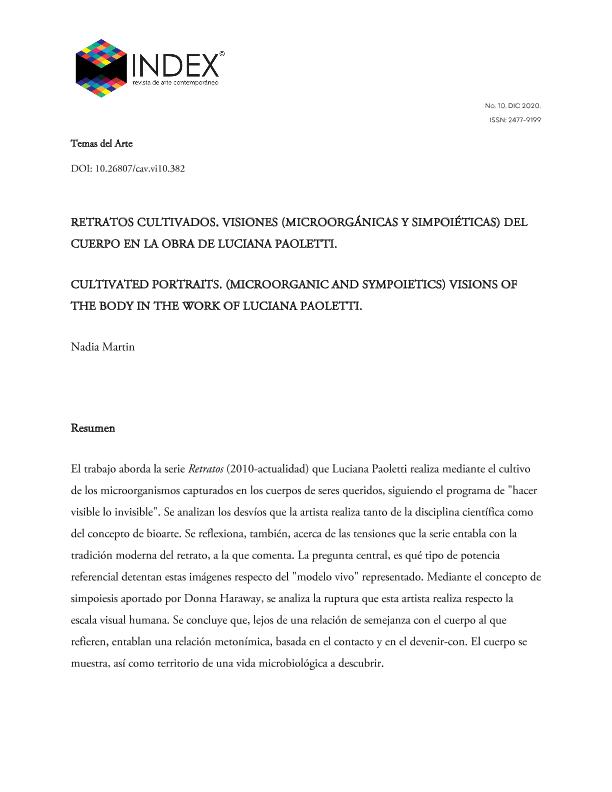Mostrar el registro sencillo del ítem
dc.contributor.author
Martin, Nadia Soledad

dc.date.available
2022-10-14T15:06:18Z
dc.date.issued
2020-12
dc.identifier.citation
Martin, Nadia Soledad; Retratos cultivados: Visiones (microorgánicas y simpoiéticas) del cuerpo en la obra de Luciana Paoletti; Pontificia Universidad Católica del Ecuador. Facultad de Arquitectura, Diseño y Artes. Carrera de Artes Visuales; Índex; 10; 12-2020; 126-142
dc.identifier.issn
2477-9199
dc.identifier.uri
http://hdl.handle.net/11336/173253
dc.description.abstract
El trabajo aborda la serie Retratos (2010-actualidad) que Luciana Paoletti realiza mediante el cultivo de los microorganismos capturados en los cuerpos de seres queridos, siguiendo el programa de "hacer visible lo invisible". Se analizan los desvíos que la artista realiza tanto de la disciplina científica como del concepto de bioarte. Se reflexiona, también, acerca de las tensiones que la serie entabla con la tradición moderna del retrato, a la que comenta. La pregunta central, es qué tipo de potencia referencial detentan estas imágenes respecto del "modelo vivo" representado. Mediante el concepto de simpoiesis aportado por Donna Haraway, se analiza la ruptura que esta artista realiza respecto la escala visual humana. Se concluye que, lejos de una relación de semejanza con el cuerpo al que refieren, entablan una relación metonímica, basada en el contacto y en el devenir-con. El cuerpo se muestra, así como territorio de una vida microbiológica a descubrir.
dc.description.abstract
The work addresses the series Retratos (2010-present) which the artist and biotechnologist Luciana Paoletti makes by cultivating the microorganisms captured in the bodies of loved ones, following the program of "making visible the invisible". I analyze the deviations that the artist makes from both the scientific discipline and the concept of bioart. I also reflect on the tensions that the series establishes with the modern tradition of portraiture, to which it comments.The central question is what kind of referential power do these images hold with respect to the "living model" represented. Through the concept of sypoietics contributed by Donna Haraway, the rupture that this artist makes with respect to the human visual scale is analyzed. It is concluded that far from a relationship of similarity with the body to which they refer, they establish a metonymic relationship, based on contact. The body is, thus, shown as the territory of a microbiological life to discover.
dc.format
application/pdf
dc.language.iso
spa
dc.publisher
Pontificia Universidad Católica del Ecuador. Facultad de Arquitectura, Diseño y Artes. Carrera de Artes Visuales
dc.rights
info:eu-repo/semantics/openAccess
dc.rights.uri
https://creativecommons.org/licenses/by-nc/2.5/ar/
dc.subject
BIOARTE CONTEMPORÁNEO
dc.subject
CUERPO
dc.subject
POSTHUMANISMO
dc.subject
RETRATO
dc.subject.classification
Otras Lengua y Literatura

dc.subject.classification
Lengua y Literatura

dc.subject.classification
HUMANIDADES

dc.subject.classification
Otras Artes

dc.subject.classification
Arte

dc.subject.classification
HUMANIDADES

dc.subject.classification
Otras Comunicación y Medios

dc.subject.classification
Comunicación y Medios

dc.subject.classification
CIENCIAS SOCIALES

dc.title
Retratos cultivados: Visiones (microorgánicas y simpoiéticas) del cuerpo en la obra de Luciana Paoletti
dc.title
Cultivated portraits: (Microorganic and sympoietics) visions of the body in the work of Luciana Paoletti
dc.type
info:eu-repo/semantics/article
dc.type
info:ar-repo/semantics/artículo
dc.type
info:eu-repo/semantics/publishedVersion
dc.date.updated
2022-10-11T19:41:07Z
dc.journal.number
10
dc.journal.pagination
126-142
dc.journal.pais
Ecuador

dc.journal.ciudad
Quito
dc.description.fil
Fil: Martin, Nadia Soledad. Consejo Nacional de Investigaciones Científicas y Técnicas; Argentina. Universidad Nacional de Tres de Febrero. Instituto de Investigaciones en Arte y Cultura "Dr. Norberto Griffa"; Argentina
dc.journal.title
Índex
dc.relation.alternativeid
info:eu-repo/semantics/altIdentifier/url/http://revistaindex.net/index.php/cav/article/view/382
dc.relation.alternativeid
info:eu-repo/semantics/altIdentifier/doi/http://dx.doi.org/10.26807/cav.vi10.382
Archivos asociados
